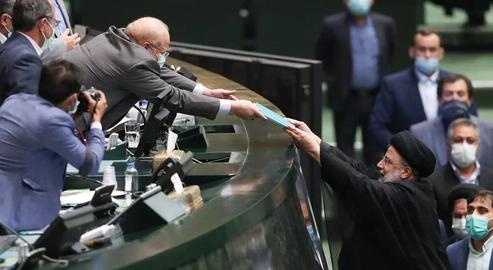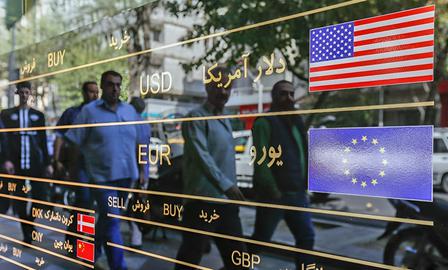On Sunday, January 9, Iranian President Ebrahim Raisi presented a report to parliament on the economic “achievements” of the 13th government, which he claimed was now leading Iran out of financial crisis. Amongst other things, he claimed inflation in Iran was “under control” and non-oil exports had increased by 40 percent since he came to power.
The comments came during Raisi’s defense of the 2022-23 budget bill. But were they accurate, and if so, do they mean anything?
Has Inflation Stopped Rising?
"Inflation is under control and has begun to decline," Raisi told MPs on Sunday. "In the past 50, 60 years of this country, this level of inflation has been unprecedented. Today, the upward trend has turned into a downward trend, which will soon lead to lower prices in various areas."
The latest report from the Statistical Center of Iran indicates that year-on-year inflation in December 2021 stood at 43.4 percent: the fifth time in the decades since the Center’s foundation that the figure topped 40 percent.
Raisi was correct to state that record-breaking inflation recorded in September 2021 may have been the peak; monthly point-to-point and annual inflation rates have been on the decline since then. That is to say, prices still continue to rise, but more slowly.
But the devil is in the detail with regard to the monthly data. According to the Statistical Center, the average increase in the price of a basket of household goods increased by 1.7 percent in December 2021 compared to the previous month. Though this was a lower rise than seen in previous months, it is still far from a sign that life in Iran is getting cheaper. On the contrary.
In fact, in May 2021, in the final months of the Raisi administration, the monthly inflation rate stood at 0.7 percent. It then surged again in the summer. The current slowing in price hikes could well only be temporary, and there is no sign at all yet of a “downward trend”.
Have Non-oil Exports Increased by 40 Percent?
In his speech, Raisi also said Iran had recorded “a 40 percent increase in non-oil exports”, with no time-frame specified. Figures on the Trade Development Organization of Iran’s website indicate the value of Iran's non-oil exports in the first nine months of 2021-2022 stood at about US$35 billion, while in the first nine months of 2020-2021, Iran's non-oil exports had been worth about $25bn.
This suggests an increase of about 40 percent in value. However, it should be remembered that the year 2020-2021 saw a collapse in international trade the world over because of the coronavirus pandemic, and Iran was no exception. Comparing the 2021-2022 nine0month figure to the first nine months of 2019-2020, all Iran appears to have done is get back to roughly pre-pandemic levels of non-oil exports.
In any event, Ebrahim Raisi only took over the presidency in mid-August and has been in office since September. Ie, the first four months of that improved reporting period took place under Hassan Rouhani. In five months, the Raisi administration actually earned $172m less in revenues from non-oil exports than the Rouhani administration did in five.
Have Foreign Exchange Reserves been Replenished?
"Exports of [Iranian] oil and condensate are on the rise today, and some are complaining that this was not possible," Raisi said. "But it was done with God's help; the currency from exports is returning to the country's foreign exchange resources. It was said that it wasn’t possible to export oil, or else that the money would not be returned, but with the increase in oil exports and the return of those funds, this problem has been solved."
There is no official data available with which to measure the accuracy of Raisi's above-quoted word salad. But if we consider foreign exchange market fluctuations as an indicator of currency stability, the price of the dollar has fluctuated a vast amount in Iran in the five months since Raisi took office. After reaching a high of 29,000 tomans in December, it has come down to 27,000 again in the past few days. Raisi, however, was sworn in at a time when the cost of a single dollar on the open market was 25,000 tomans.
Is Iran’s Foreign Policy Neutralizing Sanctions?
Since his government came to power, Raisi claimed, Tehran’s foreign policy had changed direction: “Relations with neighbors have improved, and [nuclear] negotiations are continuing in a dignified manner.”
There is no clear evidence to support the first claim, unless Raisi was referring to early talks with Saudi Arabia that took place in October. Meanwhile, at the time Raisi became president, the nuclear talks had reached an optimistic stage, with draft agreements on a return to the JCPOA reportedly conveyed back to Tehran and the P5+1 capitals. Then, all the news abruptly pointed to yet another breakdown in negotiations.
The eighth round of talks began on December 27, with new “difficult decisions” reportedly being taken by both Washington and Tehran. In essence, Raisi’s tenure has done nothing but delay a possible lifting of sanctions by four months.
Is Eight Percent Economic Growth Achievable in a Year?
"This government's goal is eight percent economic growth,” Raisi said, “and we hope these actions will lead us to this level of growth, because in previous years we had serious problems and saw growth of less than one percent. This growth is achievable with the help and support of parliament. It will help create employment in its shadow, move production forward, and address many of the concerns in the country."
Eight percent economic growth has been the goal of every Iranian government for the past 30 years. This is for the simple reason that it is defined as an annual target in each of the National Development Plans. Had it been achieved from the get-go and every year, Iranian GDP would be double what it stood at in 2021-2022.
Instead, in 2011-2012 overall growth was nearly zero. Due to policy decisions by the Islamic Republic that led to sanctions, the economy then began to shrink, and continued to do so for most of the next decade. In the meantime, the Iranian population increased by about 13 percent. Even if sanctions were lifted tomorrow and the Iranian economy surged for a while, the nature of oil exports would mean this stopped after a year or so.
In fact, neither in the proposed budget for 2022-2023, nor in any other government document, is there any sign of the real shift in approach that could draw Iran out of economic crisis in a lasting way.
Related coverage:
Raisi’s Don Quixote Cabinet and Hopes for Economic Recovery
How Much Does an Omelet Cost in Iran?
Iran’s “Stable” Currency Market Will Never Last
What's Happening to the Stock Exchange Under Ebrahim Raisi?
Iran's 'Empty Treasury' Panic is Back With a Vengeance. Who's Right?
Record-Breaking Inflation Confronts Raisi's New Presidency
Oil, the Dollar and Inflation: How Far Can the Economic Crisis in Iran Go?
visit the accountability section
In this section of Iran Wire, you can contact the officials and launch your campaign for various problems





















comments